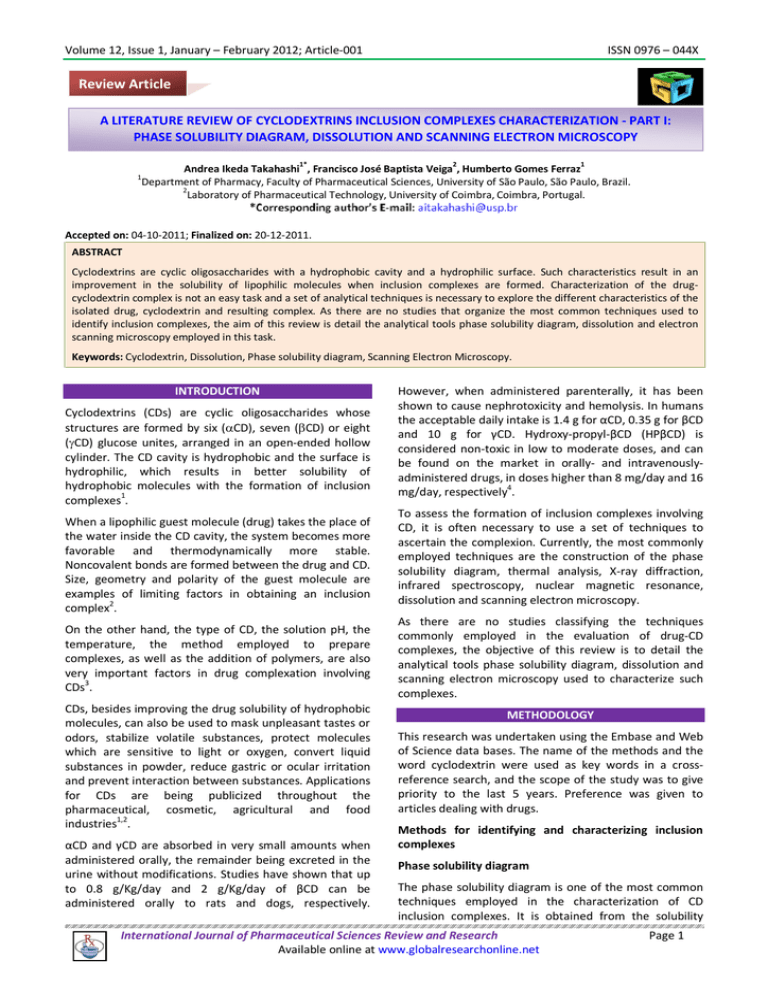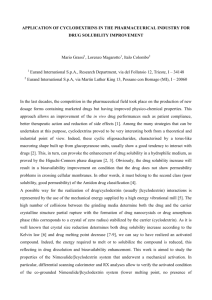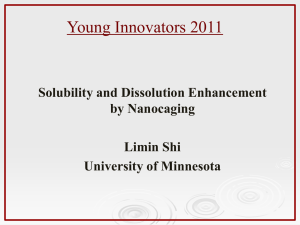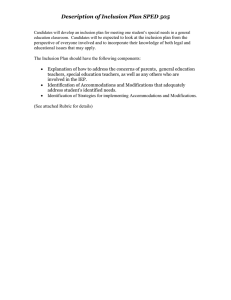Document 13308647
advertisement

Volume 12, Issue 1, January – February 2012; Article-001
ISSN 0976 – 044X
Review Article
A LITERATURE REVIEW OF CYCLODEXTRINS INCLUSION COMPLEXES CHARACTERIZATION - PART I:
PHASE SOLUBILITY DIAGRAM, DISSOLUTION AND SCANNING ELECTRON MICROSCOPY
1*
1
2
1
Andrea Ikeda Takahashi , Francisco José Baptista Veiga , Humberto Gomes Ferraz
Department of Pharmacy, Faculty of Pharmaceutical Sciences, University of São Paulo, São Paulo, Brazil.
2
Laboratory of Pharmaceutical Technology, University of Coimbra, Coimbra, Portugal.
Accepted on: 04-10-2011; Finalized on: 20-12-2011.
ABSTRACT
Cyclodextrins are cyclic oligosaccharides with a hydrophobic cavity and a hydrophilic surface. Such characteristics result in an
improvement in the solubility of lipophilic molecules when inclusion complexes are formed. Characterization of the drugcyclodextrin complex is not an easy task and a set of analytical techniques is necessary to explore the different characteristics of the
isolated drug, cyclodextrin and resulting complex. As there are no studies that organize the most common techniques used to
identify inclusion complexes, the aim of this review is detail the analytical tools phase solubility diagram, dissolution and electron
scanning microscopy employed in this task.
Keywords: Cyclodextrin, Dissolution, Phase solubility diagram, Scanning Electron Microscopy.
INTRODUCTION
Cyclodextrins (CDs) are cyclic oligosaccharides whose
structures are formed by six (CD), seven (CD) or eight
(CD) glucose unites, arranged in an open-ended hollow
cylinder. The CD cavity is hydrophobic and the surface is
hydrophilic, which results in better solubility of
hydrophobic molecules with the formation of inclusion
complexes1.
When a lipophilic guest molecule (drug) takes the place of
the water inside the CD cavity, the system becomes more
favorable and thermodynamically more stable.
Noncovalent bonds are formed between the drug and CD.
Size, geometry and polarity of the guest molecule are
examples of limiting factors in obtaining an inclusion
complex2.
On the other hand, the type of CD, the solution pH, the
temperature, the method employed to prepare
complexes, as well as the addition of polymers, are also
very important factors in drug complexation involving
3
CDs .
CDs, besides improving the drug solubility of hydrophobic
molecules, can also be used to mask unpleasant tastes or
odors, stabilize volatile substances, protect molecules
which are sensitive to light or oxygen, convert liquid
substances in powder, reduce gastric or ocular irritation
and prevent interaction between substances. Applications
for CDs are being publicized throughout the
pharmaceutical, cosmetic, agricultural and food
1,2
industries .
αCD and γCD are absorbed in very small amounts when
administered orally, the remainder being excreted in the
urine without modifications. Studies have shown that up
to 0.8 g/Kg/day and 2 g/Kg/day of βCD can be
administered orally to rats and dogs, respectively.
However, when administered parenterally, it has been
shown to cause nephrotoxicity and hemolysis. In humans
the acceptable daily intake is 1.4 g for αCD, 0.35 g for βCD
and 10 g for γCD. Hydroxy-propyl-βCD (HPβCD) is
considered non-toxic in low to moderate doses, and can
be found on the market in orally- and intravenouslyadministered drugs, in doses higher than 8 mg/day and 16
mg/day, respectively4.
To assess the formation of inclusion complexes involving
CD, it is often necessary to use a set of techniques to
ascertain the complexion. Currently, the most commonly
employed techniques are the construction of the phase
solubility diagram, thermal analysis, X-ray diffraction,
infrared spectroscopy, nuclear magnetic resonance,
dissolution and scanning electron microscopy.
As there are no studies classifying the techniques
commonly employed in the evaluation of drug-CD
complexes, the objective of this review is to detail the
analytical tools phase solubility diagram, dissolution and
scanning electron microscopy used to characterize such
complexes.
METHODOLOGY
This research was undertaken using the Embase and Web
of Science data bases. The name of the methods and the
word cyclodextrin were used as key words in a crossreference search, and the scope of the study was to give
priority to the last 5 years. Preference was given to
articles dealing with drugs.
Methods for identifying and characterizing inclusion
complexes
Phase solubility diagram
The phase solubility diagram is one of the most common
techniques employed in the characterization of CD
inclusion complexes. It is obtained from the solubility
International Journal of Pharmaceutical Sciences Review and Research
Available online at www.globalresearchonline.net
Page 1
Volume 12, Issue 1, January – February 2012; Article-001
results of the guest molecule in increasing concentrations
of CDs1.
According to a model proposed by Higuchi and Connors5,
the diagrams can be of type A, where the solubility of the
guest molecule increases as the CD concentration rises,
indicating the formation of soluble complexes, or type B,
when the complex is insoluble and the concentration of
the guest molecule decreases as CD increases (Figure 1).
Furthermore, the diagrams can be classified as AL (linear)
type, with a straight positive gradient; AN (negative), with
an initial positive gradient, which, after a certain CD
concentration, tends to negative; and AP (positive), with a
positive gradient, which, after a certain CD concentration,
becomes more pronounced.
In the AL-type diagram, the linear increase in solubility
depends on the CD concentration, and if the slope is less
than or equal to one, a stoichiometry of 1:1 is assumed.
Furthermore, a slope of greater than one indicates a
higher order of complex formation with regards to the
guest molecule. When the diagram is of AP-type, the
complexes formed are of greater order greater than one
for the host molecule after a certain concentration of CD,
and diagrams of the AN-type may be explained by
changes in the solubilizing agent at high concentrations or
aggregation of the complexes formed4.
ISSN 0976 – 044X
Kc= slope/S0 (1-slope)
Where S0 is the intrinsic solubility of the guest molecule.
AL-type diagrams are the most common when CD
inclusion complexes are being evaluated. In such cases,
the Kc value is calculated to determine the bond strength
of the guest molecule to the host. In Table 1, the values
for Kc and the bond strengths are defined6.
Table 1: Bond strength between the guest molecule and
CD, and the values for Kc
-1
Kc value (M )
<500
500-1000
1000-5000
5000-20000
>20000
Bond strength
Very weak
Weak
Moderate
Strong
Very strong
For guest molecules with low solubility with AL-type
diagrams, there may be differences between the
solubility in an aqueous medium and the interception of
the line in y, resulting in different Kc values. Alternatively,
a value for complexation efficiency (CE) can be calculated.
It considers only the slope value of the line equation of
the diagram.
CE= Slope/(1-Slope)
The ratio of guest molecule to CD and the increase in
formulation bulk with the addition of CD can also be
determined from the CE value7,8.
Guest Molecule:CD= 1/ (1+1/CE)
Increase in formulation bulk = (MWCD/MW Guest
molecule) (1+1/CE)
Where MWCD is the molecular weight of cyclodextrin and
MW guest molecule is the molecular weight of the guest
molecule.
However, the use of CE is not the most usual method of
assessing the complexation of drugs with CDs. There are a
few studies in scientific literature that use this
parameter9-12.
Figure 1: Types of phase solubility diagrams obtained
from the complexation of drugs with cyclodextrins.
Type-B diagrams can take the BS (soluble) conformation
where the complex has limited solubility. Initially, there is
an increasing concentration of the guest molecule, and
when it reaches the limit of solubility, precipitation
occurs, thus lowering the concentration. Type-BI
diagrams (insoluble) are obtained when the complex is
insoluble and there is an initial balance, but after a certain
concentration, complex precipitation occurs1,4.
When the diagram shows the conformation of the ALtype, in other words, the rise in solubility is linear as CD
concentration increases, the stability constant (Kc) can be
calculated using the following equation:
Moreover, the Kc value is found in a much larger number
of studies, some examples of which are shown in Table 2.
This is an indication of the extent of researcher
preference for this parameter.
Dissolution
The dissolution test is used to evaluate the occurrence of
complexation, where the objective of complex formation
is to increase the aqueous solubility of poorly soluble
drugs. In some studies the dissolution profile is obtained
using tablets of the drug, the physical mixture or the
complex plus excipients14, and in others the dissolution
profile is obtained from powder, without compression58.
An evaluation of the complexation is made by comparing
the amount of drug dissolved and the dissolution
International Journal of Pharmaceutical Sciences Review and Research
Available online at www.globalresearchonline.net
Page 2
Volume 12, Issue 1, January – February 2012; Article-001
efficiency (Figure 2). When the formation of the complex
occurs, higher dissolution efficiency is expected than that
of either the drug or the physical mixture. This occurs
because of the increased solubility provided by the
59
complexation of the drug .
ISSN 0976 – 044X
Table 3: Some examples of recent studies that use dissolution
profiles for the characterization of inclusion complexes
Guest molecule
CD
Aceclofenac
HPβCD
Bicalutamide
βCD
Budesonide
γCD
Bupivacaine
hydrochloride
βCD and
EPIβCD
Camptothecin
βCD
Carvedilol
MβCD
Cefdinir
βCD and
HPβCD
Celecoxib
HPβCD
21
Celecoxib
Clarithromycin
Danazol
22
Efavirenz
βCD
βCD
HPβCD
βCD, HPβCD
and RMβCD
βCD, HPβCD
and γCD
Table 2: Some examples of recent studies that use the phase
solubility diagram in the characterization of inclusion complexes
Guest molecule
5-nitroindazole
Aceclofenac
AG11
Benzophenone-3
Bicalutamide
Candesartan
cilexetil
Carvedilol
Cefdinir
Celecoxib
Dipyridamole
Efavirenz
Etodolac
Etoricoxib
Finasteride
Flavonols
Fluorofenidone
Flurbiprofen
Glyburide
Granisetron
Granisetron
Hydrocortisone
Hydroximethyl
nitrofurazone
Ibuprofen
Imatinib
Iprodione
Irbesartan
Itraconazole
Lamotrigine
Lidocain
CD
a
Diagram
type
AL
AL
AL
AL
AL
Ref
13
DMβCD
HPβCD
HPβCD
HPβCD
βCD
αCD, βCD, γCD and
HPβCD
b
MβCD
βCD and HPβCD
HPβCD
βCD
c
βCD, HPβCD and RMβCD
βCD, HPβCD and γCD
HPβCD
HPβCD
βCD
βCD and HPβCD
HPβCD
βCD and HPβCD
βCD and HPβCD
αCD and γCD
βCD and γCD
AL
18
AL
AL
AL
AL
AL and AP
AL and BS
AL
AL
AL
AL
AL
AL
AL
BS
BS
19
HPβCD
AL
Loratadine
Losartan potassium
Meloxicam
Miconazole
βCD, MβCD and HPβCD
βCD and RMβCD
βCD
βCD
d
HPβCD and SBEβCD
βCD
βCD
αCD, βCD, HPβCD and
γCD
e
Heptakis -DMβCD
HPβCD
βCD
βCD
Nefopam
βCD and derivatives
AL and AN
Omeprazole
Oxaprozin
MβCD
βCD, DMβCD and RMβCD
αCD, βCD, HPβCD and
γCD
αCD
αCD and βCD
HPβCD
HPβCD
βCD
βCD
βCD
HPβCD
Loratadine
14
15
16
17
20
23
Etodolac
24
25
26
Etoricoxib
HPβCD
Finasteride
HPβCD
Fluorofenidone
βCD e HPβCD
Glyburide
βCD and
HPβCD
33
Granisetron
HPβCD
AL
AL
AL
AL
AP and AL
AL
AN
34
Halofantrina
HPβCD
Ibuprofen
βCD
Irbesartan
Itraconazole
AP and AL
41
AL
BS
AL
AL
42
βCD
HPβCD
EPIβCD and
EPICMβCDa
αCD, βCD,
HPβCD and
γCD
Heptakis DMβCD
27
28
29
30
31
31
32
35
36
37
38
39
Ketoprofen
40
Loratadine
Loratadine
43
44
46
Prednisone
f
Pyrimethamine
Simvastatin
Spironolactone
Sulfadiazine
TG44
Triclosan
Zaleplon
Zerumbone
a
DMβCD: Dimethyl-βCD
b
MβCD: Methyl-βCD
c
RMβCD: Randomly-methylated-βCD
d
SBEβCD: Sulfobutylether-βCD
e
Heptakis -DMβCD: heptakis-(2.6-di-O-methyl)-βCD
f
MβCD: Dimethyl-βCD
Loratadine
DIMEBb
Lovastatin
HPβCD
45
AL
AL
47
AL and BS
49
AL
AL and AP
AL
AL
AL
BS
AL
AP
50
48
Losartan
potassium
Metformin
Triacetil-βCD
Naproxen
HPβCD
Omeprazole
βCD and
MβCD
Oxaprozin
βCD, DMβCD
and RMβCD
Piroxicam
HPβCD
Simvastatin
HPβCD
βCD and
EPIβCD
βCD
HPβCD
51
52
53
54
55
56
57
Triclosan
Zaleplon
Evidence of complexation
Dissolution efficiency in 10
minutes
Time required to release 90%
Percentage dissolved in 15
minutes
Percentage dissolved in 90
minutes
Percentage dissolved in 24
hours
Dissolution rate
Percentage dissolved in 5, 10,
30 and minutes
Percentage dissolved in 10
minutes
Time required to release 50%
Dissolution rate
Percentage dissolved
Dissolution efficiency in 30 and
180 minutes
Percentage dissolved in 5
minutes
Percentage dissolved in 2, 15
and 30 minutes and
dissolution efficiency in 45
minutes
Dissolution rate
Percentage dissolved in 2
minutes
Percentage dissolved in 10 and
60 minutes
Percentage dissolved in 120
minutes
Percentage dissolved in 60 and
180 minutes
Percentage dissolved in 15 and
75 minutes
Dissolution rate
Percentage dissolved
Percentage dissolved in 60
minutes
Percentage dissolved in 5
minutes
Percentage dissolved in 120
minutes
Percentage dissolved in 120
minutes
Percentage dissolved in 30
minutes and time required to
release 50%
Percentage dissolved in 24
hours
Time required to release 50%
Percentage dissolved in 10 and
30 minutes, dissolution
efficiency in 60 minutes and
dissolution rate in 5 minutes.
Percentage dissolved in 6
minutes, dissolution efficiency
in 60 minutes
Dissolution rate
Percentage dissolved in 10 and
60 minutes
Percentage dissolved
Percentage dissolved in 120
minutes
Time required to release 90%
a
EPICMβCD: Epichlorohydrincarboxymethylathed-β-CD
DIMEB: Dimethyl-β-CD
b
International Journal of Pharmaceutical Sciences Review and Research
Available online at www.globalresearchonline.net
Page 3
Ref
14
17
60
61
62
19
20
21
63
64
65
23
24
25
26
28
30
31
66
58
37
67
68
41
69
70
71
43
72
73
74
48
75
76
55
56
Volume 12, Issue 1, January – February 2012; Article-001
Table 4: Some examples of recent studies that feature the use
of scanning electron microscopy in the characterization of
inclusion complexes
Guest
molecule
Aceclofenac
b
API
a
CD
Evidence of complexation
Ref
HPβCD
γCD and
c
RAMEB
Formation of a single phase
Loss of original shape and
formation of a single phase
Loss of original shape and
formation of a single phase
14
Loss of the crystallinity
61
63
BMDBM
HPβCD
Bupivacaine
hydrochloride
Celecoxib
Clarithromycin
βCD and
EPIβCD
βCD
βCD
Coumestrol
βCD
Dipyridamole
βCD
βCD, HPβCD
and RMβCD
Enalapril
maleate
Ibuprofen
Irbesartan
Itraconazole
βCD
βCD
HPβCD
Metformin
Triacetil-βCD
Omeprazole
βCD and
MβCD
Formation of a single phase
Formation of a single phase
Loss of original shape and
formation of a single phase
Formation of a single phase
Loss of original shape and
formation of a single phase
Loss of original shape and
formation of a single phase
Loss of original shape
Loss of original shape
Loss of original shape
Loss of original shape and
formation of a single phase
Loss of original shape and
formation of a single phase
Oxaprozin
βCD, DMβCD
and RMβCD
Loss of original shape and
formation of a single phase
Efavirenz
βCD
77
78
79
80
22
23
81
58
37
complex with the drug, CD and physical mixture. When
inclusion complexes are formed, the image, contrary to
the physical mixture, does not have two distinct
components, but rather only one, which is different from
74
the original form .
Recent works featuring the use of scanning electron
microscopy to evaluate the formation of inclusion
complexes are presented in Table 4.
CONCLUSION
Characterizing complex drug-CDs is not a simple task and
requires the use of various analytical methods, which
have been discussed in this study. Such analyses must be
performed together, as each method explores a feature
of the inclusion complex, before a decision is made about
complexation.
REFERENCES
72
1. Veiga FJB,Pecorelli CCMF, Ribeiro LSS, As ciclodextrinasem
tecnologia farmacêutica.1 ed., Minerva Coimbra Editora, Coimbra,
2006, 228p.
74
2. Valle EMMD. Cyclodextrins and their uses: a review, Process
Biochem., 39, 2004, 1033-1046.
48
3. Challa R,AhujaA.,Ali J,Khar RK,Cyclodextrin in drug delivery: An
update review,AAPS Pharm. Sci. Tech., 6, 2005, E329-E357.
67
75
Piroxicam
ISSN 0976 – 044X
HPβCD
Loss of original shape
αCD, βCD,
Loss of original shape and
49
Prednisone
HPβCD and
formation of a single phase
γCD
9
Ropivacaine
HPβCD
Formation of a single phase
59
Simvastatin
HPβCD
Loss of original shape
βCD and
Loss of original shape and
82
Vinpocetin
SBEβCD
formation of a single phase
a
BMDBM: Butyl methoxydibenzoylmethane
b
API: drug was referred by the authors as API due to reasons of
Industrial Property Rights
c
RAMEB: Randomly methylated beta cyclodextrin
4. Brewster ME, Loftsson, T,Cyclodextrins as pharmaceutical
solubilizers, Adv. Drug Delivery Rev., 59, 2007, 645-666.
5. Higuchi T, Connors, AK,.Phase-solubility techniques, Adv. Anal.
Chem. Instrum., 4, 1965, 117-212.
6. Carrier RL, Miller LA, Ahmed I, The utility of cyclodextrins for
enhancing oral bioavailability, J. Controlled Release, 123, 2007, 7899.
7. Loftsson
T,Hreinsdóttir
D,Másson
M,
Evaluation
of
cyclodextrinsolubilization of drugs, Int. J. Pharm., 302, 2005, 18-28.
8. Loftsson T,HreinsdóttirD,Másson M, The complexation efficiency,
J.Incl.Phenom. Macrocycl.Chem., 57, 2007, 545-542.
9. Araujo
DR,TsunedaSS,Cereda
CMS,Carvalho
FGF,Preté
PSC,Fernandes SA,Yokaichiya F, Franco MKKD, MazzaroI,Fraceto LF,
Braga AFA, Paula E,Development and pharmacological evaluation of
ropivacaine-2-hydroxypropyl-β-cyclodextrin inclusion complex,Eur.
J. Pharm. Sci., 33, 2008, 60-71.
10. Jug M,Becirevic-Lacan M,Bengez S, Novel cyclodextrin-based film
formulation intended for buccal delivery of atenolol, Drug Dev. Ind.
Pharm., 35, 2009, 796-807.
11. MeloNFS,Grillo R, Rosa AH,Fraceto LF,Interaction between
nitroheterocyclic compounds with β-cyclodextrins: Phase solubility
and HPLC studies,J. Pharm. Biomed. Anal., 47, 2008, 865-869.
12. Tewes F,Brillault J,Couet W, Olivier JC, Formulation of rifampicin cyclodextrin complexes for lung nebulization, J. Controlled Release,
129, 2008, 93-99.
Figure 2: Hypothetical model of dissolution analysis for
the inclusion complex (A), physical mixture (B) and
complexed drug (C).
Table 3 presents recent studies that use dissolution
profiles to assess the formation of inclusion complexes.
Scanning electron microscopy
Scanning electron microscopy is a technique used to
qualitatively define the formation of inclusion complexes.
Analysis is carried out by morphologically comparing the
13. Jullian C, Morales-Montecinos J, Zapata-Torres G, Aguilera B,
Rodriguez J,Arán V,Olea-Azar C, Characterization, phase-solubility,
and molecular modeling of inclusion complex of 5-nitroindazole
derivative with cyclodextrins, Bioorg. Med. Chem., 16, 2008, 50785084.
14. Dahiya S,PathakK, Influence of amorphous cyclodextrin derivatives
on
aceclofenac
release
from
directly
compressible
tablets,Pharmazie, 62, 2007, 278-283.
15. Stancanelli R,Ficarra R,Cannavà C, Guardo M,Calabrò ML,Ficarra
P,Ottanà R,Maccari R,Crupi V, Majolino D,Venuti V, UV-vis and FTIRATR
characterization
of
9-fluorenon-2-carboxyester/
(2hydroxypropyl)-β-cyclodextrin inclusion complex,J. Pharm. Biomed.
Anal., 47, 2008, 704-709.
International Journal of Pharmaceutical Sciences Review and Research
Available online at www.globalresearchonline.net
Page 4
Volume 12, Issue 1, January – February 2012; Article-001
ISSN 0976 – 044X
16. Berbicz F,Nogueira AC,Neto AM,Natali MRM,Baesso ML,Matioli G,
Use of photoacoustic spectroscopy in the characterization of
inclusion
complexes
of
benzophenone-3-hydroxypropyl-βcyclodextrin and ex vivo evaluation of the percutaneous penetration
of sunscreen, Eur. J. Pharm. Biopharm., 2011, doi:
10.1016/j.ejpb.2011.03.026.
34. DiCagno M, Stein PC,Skalko-Basnet N,Brandl M, Bauer-Brandl
A,Solubilization of ibuprofen with β-cyclodextrin derivatives:
Energetic and structural studies,J. Pharm. Biomed. Anal., 55, 2011,
446-451.
17. Patil AL, Pore YV,Kuchekar BS, Late SG, Solid-state characterization
and dissolution properties of bicalutamide-β-cyclodextrin inclusion
complex,Pharmazie, 63, 2008, 282-285.
35. Beni
S,Szakács
Z,Csernák
O,Barcza
L,
Noszál
B,Cyclodextrin/imatinibcomplexation: Binding mode and charge
dependent stabilities,Eur. J. Pharm. Sci., 30, 2007, 167-174.
18. AlOmari AA, AlOmari MM,Badwan AA, AL-Sou’Od KA, Effect of
cyclodextrins on the solubility and stability of candesartan cilexetil
in solution and solid state, J. Pharm. Biom. Anal., 54, 2011, 503-509.
36. Zhu XL, Wang HB, Chen Q, Yang WC, Yang GF, Preparation and
characterization of inclusion complex of iprodione and βcyclodextrin to improve fungicidal activity,J. Agric. Food Chem., 55,
2007, 3535-3539.
19. Hirlekar R, Kadam V,Preparation and characterization of inclusion
complexes of carvedilol with methyl-β-cyclodextrin, J. Incl. Phenom.
Macrocycl. Chem., 63, 2009, 219-224.
20. Aleem O, Kuchekar B, Pore Y, Late S, Effect of β-cyclodextrin and
hydroxypropyl β-cyclodextrin complexation on physicochemical
properties and antimicrobial activity of cefdinir, J. Pharm. Biomed.
Anal., 47, 2008, 535-540.
21. Capello B, DiMaio C, Iervolino M,Miro A, Combined effect of
hydroxypropyl methylcellulose and hydroxypropyl-β-cyclodextrin on
physicochemical and dissolution properties of celecoxib,J. Incl.
Phenom. Macrocycl. Chem., 59, 2007, 237-244.
22. AlOmari
MM,
El-Barghouthi
MI,Zughul
MB,
Davies
JED,Dipyridamole/β-cyclodextrincomplexation: Effect of buffer
1
species, thermodynamics, and guest-host interactions probed by HNMR and molecular modeling studies,J. Incl. Phenom. Macrocycl.
Chem., 64, 2009, 305-315.
hydroxymethylnitrofurazone and 2-hydroxypropyl-β-cyclodextrin,J.
Pharm. Biomed. Anal.,47, 2008, 295-302.
37. Hirlekar R,Kadam V,Preformulation Study of the Inclusion Complex
Irbesartan-β-Cyclodextrin,AAPS Pharm. Sci. Tech., 10, 2009, 276281.
38. Brewster ME,Vandecruys R,Peeters J,Neeskens P,Verreck G,Loftsson
T, Comparative interaction of 2-hydroxypropyl-β-cyclodextrin and
sulfobutylether-β-cyclodextrin with itraconazole: Phase-solubility
behavior and stabilization of supersaturated drug solutions,Eur. J.
Pharm. Sci., 34, 2008, 94-103.
39. Shinde VR,Shelake MR,Shetty SS,Chavan-Patil AB, Pore YV, Late SG,
Enhanced solubility and dissolution rate of lamotrigine by inclusion
complexation and solid dispersion technique,J. Pharm. Pharmacol.,
60, 2008, 1121-1129.
40. Tatai A,Aigner Z, Eros I, Kata M, Preparation and investigation of
mixtures containing lidocaine base and β-cyclodextrin,J. Incl.
Phenom. Macrocycl. Chem.,59, 2007, 105-113.
23. Sathigari S,Chadha G, Lee YHP, Wright N, Parsons DL,Rangari
VK,Fasina O,BabuRJ, Physicochemical characterization of efavirenzcyclodextrin inclusion complexes,AAPS Pharm. Sci. Tech., 10, 2009,
81-87.
41. Omar L, El-Barghouthi MI,Masoud NA, Abdoh AA,Al-Omari
MM,Zughul MB,Badwan AA, Inclusion complexation of loratadine
with natural and modified cyclodextrins:phase solubility and
thermodynamic studies,J. Solution Chem., 36, 2007, 605-616.
24. Cappello
B,
DiMaio
C,Iervolino
M,Miro
A,Calignano
A,Etodolac/cyclodextrin
formulations:
Physicochemical
characterization and in vivo pharmacological studies,Drug Dev. Ind.
Pharm., 35, 2009, 877-886.
42. Nacsa A,Berkesi O,Szabó-Révész P,Aigner Z, Achievement of pHindependence of poorly-soluble, ionizable loratadine by inclusion
complex formation with dimethyl-b-cyclodextrin,J. Incl. Phenom.
Macrocycl. Chem.,64, 2009, 249-254.
25. Shah M,Karekar P,Sancheti P,Vyas V, Pore Y, Effect of PVP K30
and/or L-Arginine on stability constant of Etoricoxib–HPβCD
inclusion complex: preparation and characterization of Etoricoxib–
HPβCD binary system,Drug Dev. Ind. Pharm., 35, 2009, 118-129.
43. De Paula W,Denadai AML, Santoro MM, Braga ANG, Santos
RAS,Sinisterra RD,Supramolecular interactions beween losartan and
hydroxypropyl-β-CD: ESI mass-spectrometry, NMR techniques,
phase solubility, isothermal titration calorimetry and antihypertensive studies,Int. J. Pharm., 404, 2011, 116-123.
26. Asbahr ACC, Franco L,Barison A, Silva CWP,Ferraz HG, Rodrigues
LNC,Binary and ternary inclusion complexes of finasteride in HPβCD
and polymers: Preparation and characterization,Bioorg. Med.
Chem., 17, 2009, 2718-2723.
27. Dias K,Nikolau S, DeGiovani WF,Synthesis and spectral investigation
of Al(III) catechin/β-cyclodextrin and Al(III) quercetin/β-cyclodextrin
inclusion compounds,Spectrochim. Acta, Part A, 70, 2008, 154-161.
44. Obaidat AA,Khanfar RA,Khawam MN, The effect of β-cyclodextrin on
the solubility and dissolution rate of meloxicam and investigation of
the driving force for complexation using molecular modeling,J. Incl.
Phenom. Macrocycl. Chem., 63, 2009, 273-279.
45. Wang J,Cai Z, Investigation of inclusion complex of miconazole
nitrate with β- cyclodextrin,Carbohydr. Polym., 72, 2008, 255-260.
28. Wang S, Ding Y, Yao Y, Inclusion complexes of fluorofenidone with β
-cyclodextrin and hydroxypropyl-β-cyclodextrin,Drug Dev. Ind.
Pharm., 35, 2009, 808-813.
46. Brun H, Paul M,Razzouq N,Binhas M,Gibaud S,Astier A,Cyclodextrin
inclusion complexes of the central analgesic drug nefopam,Drug
Dev. Ind. Pharm., 32, 2006, 1123-1134.
29. Kim JK, Kim MS, Park JS, Kim CK, Thermo-reversible flurbiprofen
liquid suppository with HP-β-CD as a solubility enhancer:
improvement of rectal bioavailability,J. Incl. Phenom. Macrocycl.
Chem., 64, 2009, 265-272.
47. Figueiras
A,Sarraguça
JMG,Carvalho
RA,Pais
AACC,Veiga
FJB,Interaction of omeprazole with a methylated derivative of βcyclodextrin: Phase solubility, NMR spectroscopy and molecular
simulation,Pharm. Res., 24, 2007, 377-389.
30. Cirri M,Righi MF,Maestrelli F, Mura P,Valleri M, Development of
glyburide fast-dissolving tablets based on the combined use of
cyclodextrins and polymers,Drug Dev. Ind. Pharm., 35, 2009, 73-82.
48. Maestrelli F,Cecchi M, Cirri M,Capasso G,Mennini N, Mura P,
Comparative study of oxaprozin complexation with natural and
chemically-modified cyclodextrins in solution and in the solid state,J.
Incl. Phenom. Macrocycl., 63, 2009, 17-25.
31. ChoHJ,Balakrishnan P, Shim WS, Chung SJ, Shim CK, Kim DD,
Characterization and in vitro evaluation of freeze-dried
microparticles composed of granisetron-cyclodextrin complex and
carboxymethylcellulose for intranasal delivery,Int. J. Pharm., 2010,
400, 59-65.
32. Messner M,Kurkov SV, Brewster ME, Jansook P,Loftsson T, Selfassembly
of
cyclodextrin
complexes:
Agregation
of
hydrocortisone/cyclodextrin complexes,Int. J. Pharm., 407, 2011,
174-183.
33. Grillo R,Melo NFS,Moraes CM, Lima R,Menezes CMS, Ferreira EI,
Rosa AH,Fraceto LF,Study of the interaction between
49. Ghuzlaan A, AlOmari MM,Al-Sou’Od KA, Prednisone/cyclodextrin
inclusion complexation: phase solubility, thermodynamic,
physicochemical and computational analysis,J. Solution Chem., 38,
2009, 83-94.
50. Araujo MVG, Macedo OFL, Nascimento CC,Conegero LS, Barreto LS,
Almeida LE, Costa-Jr NB, Gimenez IF,Characterization,
phasesolubilityand
molecular
modelingofαcyclodextrin/pyrimethamineinclusioncomplex,Spectrochim.
Acta,
Part A, 72, 2009, 165-170.
International Journal of Pharmaceutical Sciences Review and Research
Available online at www.globalresearchonline.net
Page 5
Volume 12, Issue 1, January – February 2012; Article-001
51. Wen X, Liu Z, Zhu T, Mass spectrometry and molecular modeling
studies on the inclusion complexes between α, β-cyclodextrins and
simvastatin,Chem. Phys. Lett., 405, 2005, 114-117.
52. Rajabi O,Tayyari F,Salari R,Tayyari SF,Study of interaction of
spironolactone with hydroxypropyl-β-cyclodextrin in aqueous
solution and in solid state,J. Mol. Struct., 878, 2008, 78-83.
53. Araújo MVG, Vieira EKB, Lázaro GS,Conegero LS, Ferreira OP,
Almeida
LE,Barreto
LS,
Costa-Jr
NB,Gimenez
IF,Sulfadiazine/hydroxypropyl-β-cyclodextrin host-guest system:
Characterization, phase-solubility and molecular modeling,Bioorg.
Med. Chem., 16, 2008, 5788-5794.
54. Anzai K,Mizoguchi J,Yanagi T, Hirayama F, Arima H,Uekama
K,Improvement of dissolution properties of a new Helicobacter
pylori eradicating agent (TG44) by inclusion complexation with βcyclodextrin,Chem. Pharm. Bull., 55, 2007, 1466-1470.
55. Jug M,Kosalec I,Maestrelli F, Mura P, Analysis of triclosan inclusion
complexes with β-cyclodextrin and its water-soluble polymeric
derivative,J. Pharm. Biom. Anal., 54, 2011, 1030-1039.
56. Doiphode D,Gaikwad S, Pore Y, Kuchekar B, Late S, Effect of βcyclodextrin complexation on physicochemical properties of
zaleplon,J. Incl. Phenom. Macrocycl. Chem., 62, 2008, 43-50.
57. Eid EEM, Abdul AB,Suliman FEO,Sukari MA,Rasedee A, Fatah SS,
Characterization of the inclusion complex of zerumbone with
hydroxypropyl-β-cyclodextrin,Carbohydrate Polymers, 83, 2011,
1707-1714.
58. Hussei K, Türk M, Wahl MA, Comparative evaluation of ibuprofen/βcyclodextrin complexes obtained by supercritical carbon dioxide and
other conventional methods,Pharm. Res., 24, 2007, 585-592.
59. Jun SW, Kim MS, Kim JS, Park HJ, Lee S, Woo JS, Hwang SJ,
Preparation and characterization of simvastatin/hydroxypropyl-βcyclodextrin inclusion complex using supercritical antisolvent (SAS)
process,Eur. J. Pharm. Biopharm., 66, 2007, 413-421.
60. Toropainen T,Velaga S,Heikkilä T,Matilainen L,Jarho P,Carlfors
J,Lehto VP,Järvinen T,Järvinem K, Preparation of budesonide/γcyclodextrin complexes in supercritical fluids with a novel SEDS
method. emulsion based formulations,J. Pharm. Sci., 95, 2006, 22352245.
61. Jug M,Maestrelli F,BragagniM, Mura P, Preparation and solid-state
characterization of bupivacaine hydrochloride cyclodextrin
complexes aimed for bucal delivery,J. Pharm.Biom.Anal., 52, 2010,
9-18.
62. Swaminathan S,Pastero L,Serpe L, Trotta F,Vavia P,Aquilano D,Trotta
M, Zara G,Cavalli R,Cyclodextrin-based nanosponges encapsulating
camptothecin: Physicochemical characterization, stability and
cytotoxity,Eur. J. Pharm. Biopharm., 74, 2010, 193-201.
63. Sinha VR, Anitha R,Ghosh S,Amita,Kumria R,Bhinge JR, Kumar M,
Physicochemical characterization and in vitrodissolution behaviour
of celecoxib-β-cyclodextrin inclusion complexes,Acta Pharm., 57,
2007, 47-60.
1. 64.Zhang X,Zou M, Li S, Chen X,Zhong D, Bioavailability of
clarithromycin cyclodextrin ternary complexes upon oral
administration to healthy beagle dogs,Drug Dev. Ind. Pharm., 34,
2008, 163-171.
64. Rogers TL, Nelsen AC, Hu J, Brown JN,Sarkari M, Young TJ, Johnston
KP, Williams III RO, A novel particle engineering technology to
enhance dissolution of poorly water soluble drugs: spray-freezing
into liquid,Eur. J. Pharm. Biopharm., 54, 2002, 271-280.
65. Onyeji CO,Omoruyi SI,Oladimeji FA, Dissolution properties and
characterization of halofantrine-2-hydroxypropyl-β-cyclodextrin
binary systems, Pharmazie, 62, 2007, 858-863.
ISSN 0976 – 044X
66. Lee SY, Jung II, Kim JK, Lim GB,Ryu JH, Preparation of
itraconazole/HP-β-CD inclusion complexes using supercritical
aerosol solvent extraction system and their dissolution
characteristics,J. Supercrit. Fluids.,44, 2008, 400-408.
67. CirriM,Bragagni M,Mennini N, Mura P, Development of a new
delivery system consisting in “drug – in cyclodextrin – in
nanostructured lipid carriers” for ketoprofen topical delivery,Eur. J.
Pharm. Biopharm., (2011), doi: 10.1016/j.ejpb.2011.07.015.
68. Nacsa A,Ambrus R,Berkesi O,Szabó-Révéz P,Aigner Z, Water-soluble
loratadine inclusion complex: Analytical control of the preparation
by microwave irradiation,J. Pharm. Biomed. Anal., 48, 2008, 10201023.
69. Szabados-Nacsa Á,Sipos P,Martinek T,Mándity I,Blazsó G,Balogh
Á,Szabó-Révész P,Aigner Z,Physico-chemical characterization and in
vitro/in vivo evaluation of loratadine:dimethyl-β-cyclodextrin
inclusion complex,J. Pharm. Biom. Anal., 55, 2011, 294-300.
70. Patel RP, Patel MM, Solid-state characterization and dissolution
properties of lovastatin hydroxypropyl-β-cyclodextrin inclusion
complex,Pharm. Tech., 31, 2007, 72-82.
71. Corti G,Capasso G,Maestrelli F, Cirri M, Mura P, Physical-chemical
characterization of binary systems of metformin hydrochloride with
triacetyl-β-cyclodextrin,J. Pharm. Biomed. Anal., 45, 2007, 480-486.
72. Mura P,Bettinetti GP, Cirri M,Maestrelli F,Sorrenti M,Catenacci L,
Solid-state characterization and dissolution properties of Naproxen–
Arginine–Hydroxypropyl-β-cyclodextrin ternary system,Eur. J.
Pharm. Biopharm., 59, 2005, 99-106.
73. Figueiras A,Carvalho RA, Ribeiro L, Torres-Labandeira JJ, Veiga
FJB,Solid-state characterization and dissolution profiles of the
inclusion complexes of omeprazole with native and chemically
modified β-cyclodextrin,Eur. J. Pharm. Biopharm., 67, 2007, 531539.
74. Zhang X, Wu D, Lai J, Lu Y, Yin Z, Wu W,Piroxicam/2-Hydroxypropylβ-Cyclodextrin Inclusion Complex Prepared by a New Fluid-Bed
Coating Technique,J. Pharm. Sci., 98, 2009, 665-675.
75. Ungaro F,Giovino C,Catanzano O,Miro A,Mele A,Quaglia F,
LaRotonda MI,Use of cyclodextrins as solubilizing agents for
simvastatin:
Effect
of
hydroxypropyl-β-cyclodextrin
on
lactone/hydroxyacid aqueous equilibrium, Int. J. Pharm., 404, 2011,
49-56.
76. Vajna B,Farkas I,Farkas A, Pataki H, Nagy Z,Madarász J,Marosi G,
Characterization of drug-cyclodextrin formulations using Raman
mapping and multivariate curve resolution,J. Pharm. Biom. Anal.,
56, 2011, 38-44.
77. Scalia S,Coppi G,Iannuccelli V,Microencapsulation of a cyclodextrin
complex of the UV filter, butyl methoxydibenzoylmethane: In vivo
skin penetration studies,J. Pharm. Biom. Anal., 54, 2011, 345-350.
78. Zhang X, Zhang Y,Zhong D, Chen Y, Li S, Investigation and
Physicochemical characterization of clarithromycin-citric acidcyclodextrins ternary complexes,Drug Dev. Ind. Pharm., 33, 2007,
163-171.
79. Franco C,Schwingel L, Lula I,Sinisterra RD, Koester LS,Bassani
VL,Studies on coumestrol/β-cyclodextrin association: Inclusion
complex characterization, Int. J. Pharm., 369, 2009, 5-11.
80. Zoppi A,Garnero C,Linck YG,Chattah AK,Monti GA,Longhi
MR,Enalapril:β-CD complex: Stability enhancement in solid
state,Carbohydrate Polymers, 86, 2011, 716-721.
81. Ribeiro LSS, Ferreira DC, Veiga FJB,Phisicochemical investigation of
the effects of water-soluble polymers on vinpocetinecomplexation
with β-cyclodextrin and its sulfobutyl ether derivate is solution and
solid state,Eur. J. Pharm. Sci., 20, 2003, 253-266.
*******************
Read this article continues parts - “literature review of cyclodextrins inclusion complexes characterization – part II and
part III” {Article 002 and 003, 12(1)}.
International Journal of Pharmaceutical Sciences Review and Research
Available online at www.globalresearchonline.net
Page 6




